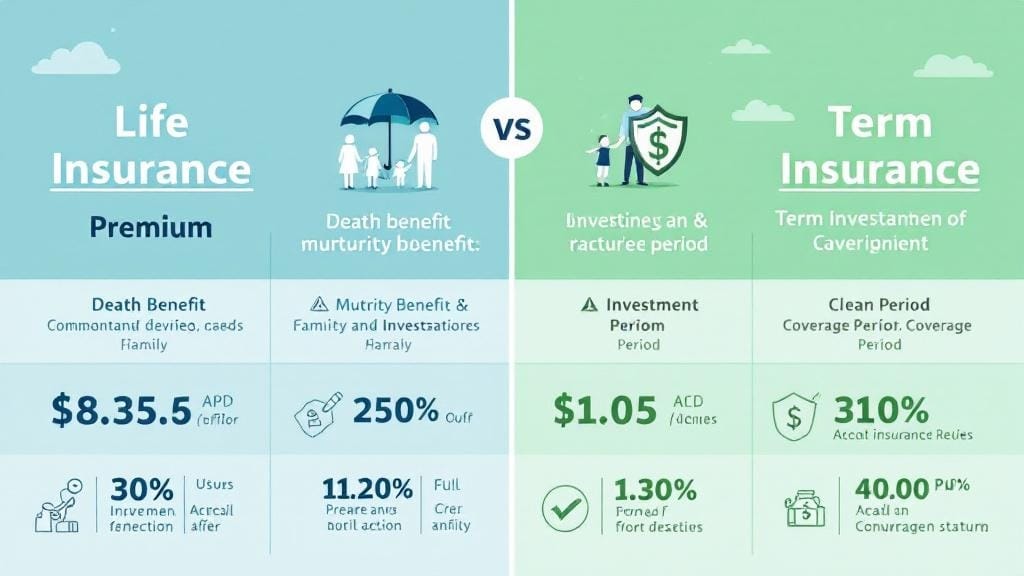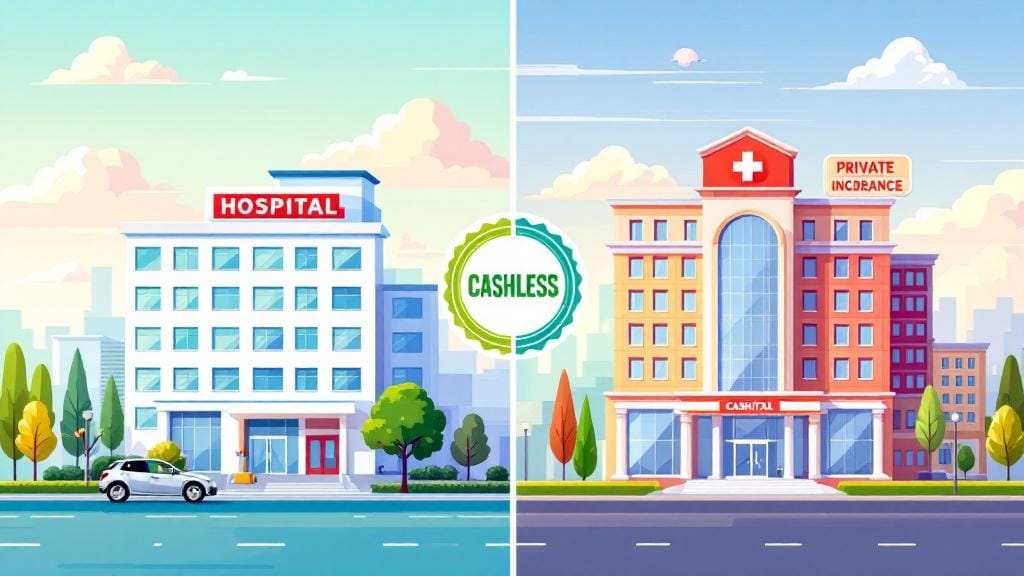When it comes to planning for the future, life insurance is a powerful financial tool. But if you’ve ever searched online or asked an advisor, you’ve probably come across terms like “term insurance”, “whole life insurance”, or even “term plan vs life insurance plan”—and things can quickly get confusing.
So what exactly is the life insurance vs term insurance difference? Which one should you choose for your financial goals in 2025?
Let’s break it down in simple, clear terms so you can make the best decision for yourself and your family.
🔍 What Is Life Insurance?
Life insurance is a broad term for a contract between you and an insurance company. You pay premiums regularly, and in return, the insurer provides a financial payout (called a death benefit) to your nominee if you pass away during the policy period.
There are different types of life insurance, but they typically fall into two broad categories:
Term insurance
Permanent life insurance (includes whole life, endowment, and ULIPs)
🆚 What Is Term Insurance?
Term insurance is the simplest and most affordable type of life insurance. It provides pure protection—that means no investment or savings component.
If the policyholder dies during the coverage period, the nominee gets the sum assured. If the policyholder survives the term, nothing is paid out.
✅ Life Insurance vs Term Insurance Difference (At a Glance)
Here’s a side-by-side term insurance and life insurance comparison to make it easier:
| Feature | Term Insurance | Life Insurance (e.g., Whole Life) |
|---|---|---|
| Purpose | Pure risk cover | Risk cover + savings/investment |
| Premium | Low | Higher |
| Death Benefit | Yes | Yes |
| Maturity Benefit | No | Yes |
| Coverage Period | Fixed term (10-40 years) | Lifelong (up to age 99 or 100) |
| Investment Component | No | Yes |
| Policy Type | Basic protection plan | Endowment, ULIP, Whole Life |
| Insurance Payout | On death during policy term | On death + returns or savings |
| Ideal For | Those wanting high coverage at low cost | Those wanting insurance + long-term savings |
💰 Understanding Premiums and Benefits
🎯 Insurance Premium
A premium is the amount you pay periodically to keep the policy active.
Term insurance premiums are significantly lower because there’s no investment or payout on survival.
Life insurance premiums are higher due to the savings or investment component included.
Example: A 30-year-old non-smoker might pay ₹8,000/year for a ₹1 crore term plan, but ₹50,000+/year for a life insurance plan of the same coverage.
💸 Sum Assured and Death Benefit
The sum assured is the guaranteed payout your nominee receives in case of your death.
In both policies, this is the primary benefit—but only term insurance focuses purely on this.
In whole life or endowment plans, there’s a mix of death benefit + maturity benefit.
🕒 Coverage Period and Maturity Benefit
📅 Coverage Period
Term plans offer coverage for a limited duration—say 20 or 30 years.
Whole life insurance can offer coverage till age 99 or even lifelong.
🎁 Maturity Benefit
Term plans do not provide a maturity benefit (unless it’s a Return of Premium plan).
Life insurance (endowment, ULIP, or whole life) includes a payout if the policyholder survives the term.
🧾 Policy Features and Types
🧩 Insurance Policy Features
Term Plans: Simple to understand, low-cost, high coverage.
Whole Life Insurance: Complex but includes long-term returns, loans, and tax-saving benefits.
🏷️ Insurance Policy Types
Term Plan
Whole Life Policy
Endowment Plan
ULIP (Unit Linked Insurance Plan)
Each has different pros and cons depending on your financial planning goals.
💭 Which Is Better: Life Insurance or Term Insurance?
The answer depends on your goals, life stage, and budget.
👍 Choose Term Insurance If:
You want maximum life cover at an affordable cost
You are the sole earning member and want to protect your family
You’re in your 20s, 30s, or 40s and starting financial planning
You want a simple, no-frills plan
👍 Choose Life Insurance (Whole Life, Endowment, ULIP) If:
You want insurance + investment/savings
You’re okay with higher premiums
You’re planning for long-term wealth creation
You want a guaranteed maturity amount
📊 Real-Life Example: Rahul and Priya
Rahul, age 30, earns ₹12 lakhs/year. He opts for a ₹1 crore term plan at ₹9,000/year. It ensures his family is covered if anything happens to him.
Priya, also 30, chooses a whole life plan with a ₹10 lakh sum assured and maturity benefit. She pays ₹50,000/year, and at maturity (age 60), she receives ₹20+ lakhs due to bonuses.
Moral: Both chose wisely—but based on their needs.
🔐 Term Insurance vs Whole Life Insurance: Quick Comparison
| Factor | Term Insurance | Whole Life Insurance |
|---|---|---|
| Premium Cost | Very Low | High |
| Savings Component | No | Yes |
| Payout on Survival | No | Yes |
| Flexibility | High | Medium |
| Returns | None | Low to Moderate |
| Tax Benefits | Yes (Under Sec 80C/10(10D)) | Yes |
🧠 Expert Tip: Combine Term and Investment Separately
Instead of choosing a bundled life insurance + investment plan, many financial advisors recommend:
✅ Buy a pure term plan for protection
✅ Invest separately in mutual funds or PPF for wealth creation
Why? Because it gives better returns, flexibility, and transparency.
❓ FAQs About Life Insurance vs Term Insurance Difference
1. What is the difference between term insurance and life insurance?
The main difference is that term insurance offers only death benefit, while life insurance includes both death and maturity benefits with an investment/savings component.
2. Which is better: life insurance or term insurance?
If you’re looking for pure protection, term insurance is better. If you want protection + savings, go with a life insurance plan.
3. Can I have both term and life insurance?
Yes, you can. Many people buy a term plan for protection and also invest in life insurance or other savings plans separately.
4. Is term insurance worth it if I survive the term?
Absolutely. Think of it like car insurance—you don’t get anything back if you don’t claim, but it’s crucial to have. The peace of mind is worth every rupee.
5. Do term plans offer tax benefits?
Yes. Premiums paid for term plans are eligible for deductions under Section 80C, and the death benefit is tax-free under Section 10(10D).
6. What happens if I stop paying my premium?
If you stop paying your premium, your policy lapses. For life insurance policies, you may have a surrender value after a certain period, but for term insurance, there’s usually no return.
7. Can I increase my life cover later?
Yes, some policies allow top-ups or add-on riders like accidental death cover, critical illness, etc. Always check the policy terms.
🎯 Final Thoughts: Life Insurance vs Term Insurance—Which One Is Right for You?
The life insurance vs term insurance difference is all about purpose.
Want pure financial protection? 👉 Go for term insurance.
Want savings + insurance in one plan? 👉 Choose life insurance.
In 2025, with inflation and uncertainty around, protecting your family is more important than ever. Whatever plan you choose, ensure it aligns with your goals, income, and future responsibilities.
Tip: Speak to a licensed insurance advisor or use trusted online comparison tools to find the best plan for you.








Comments (0)